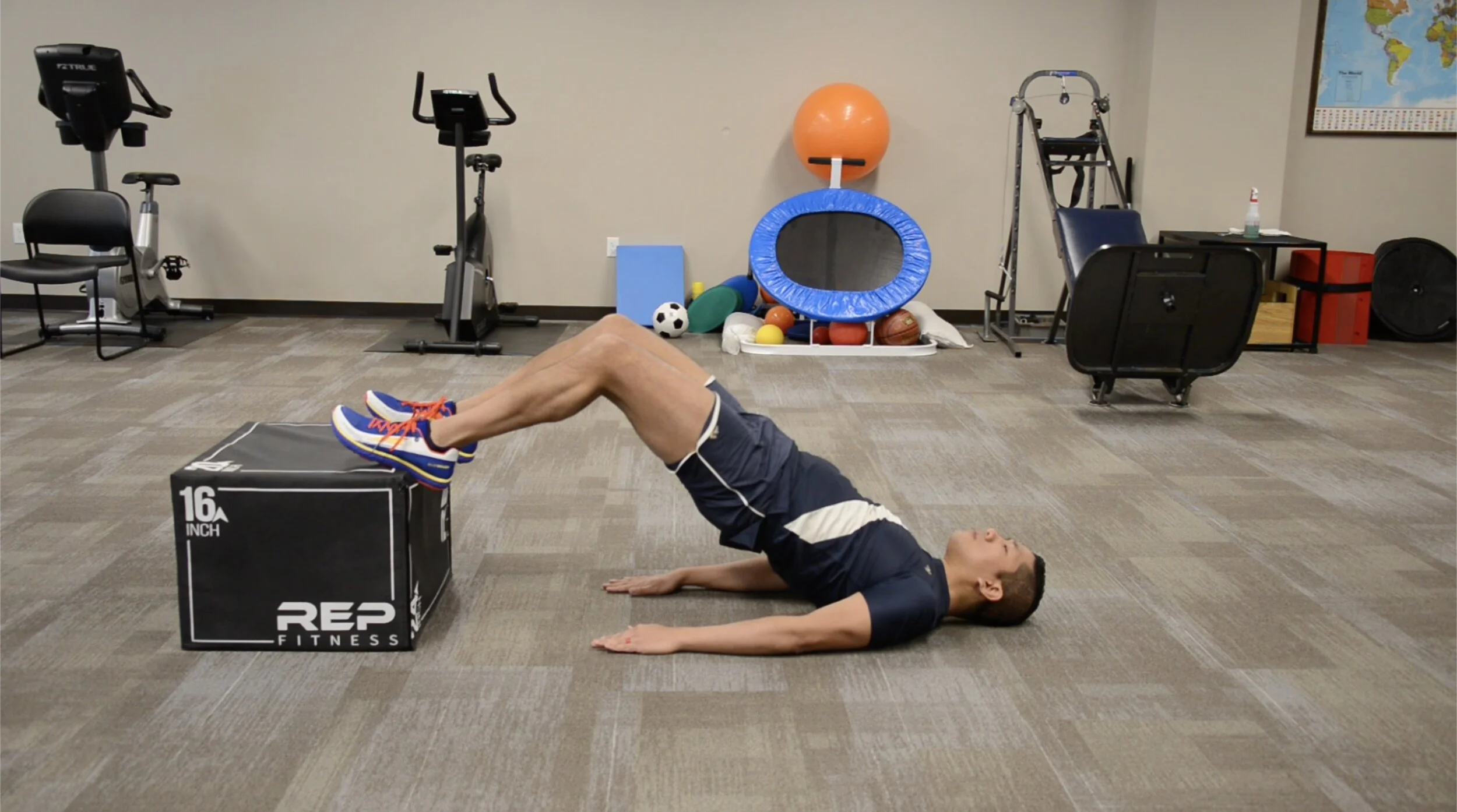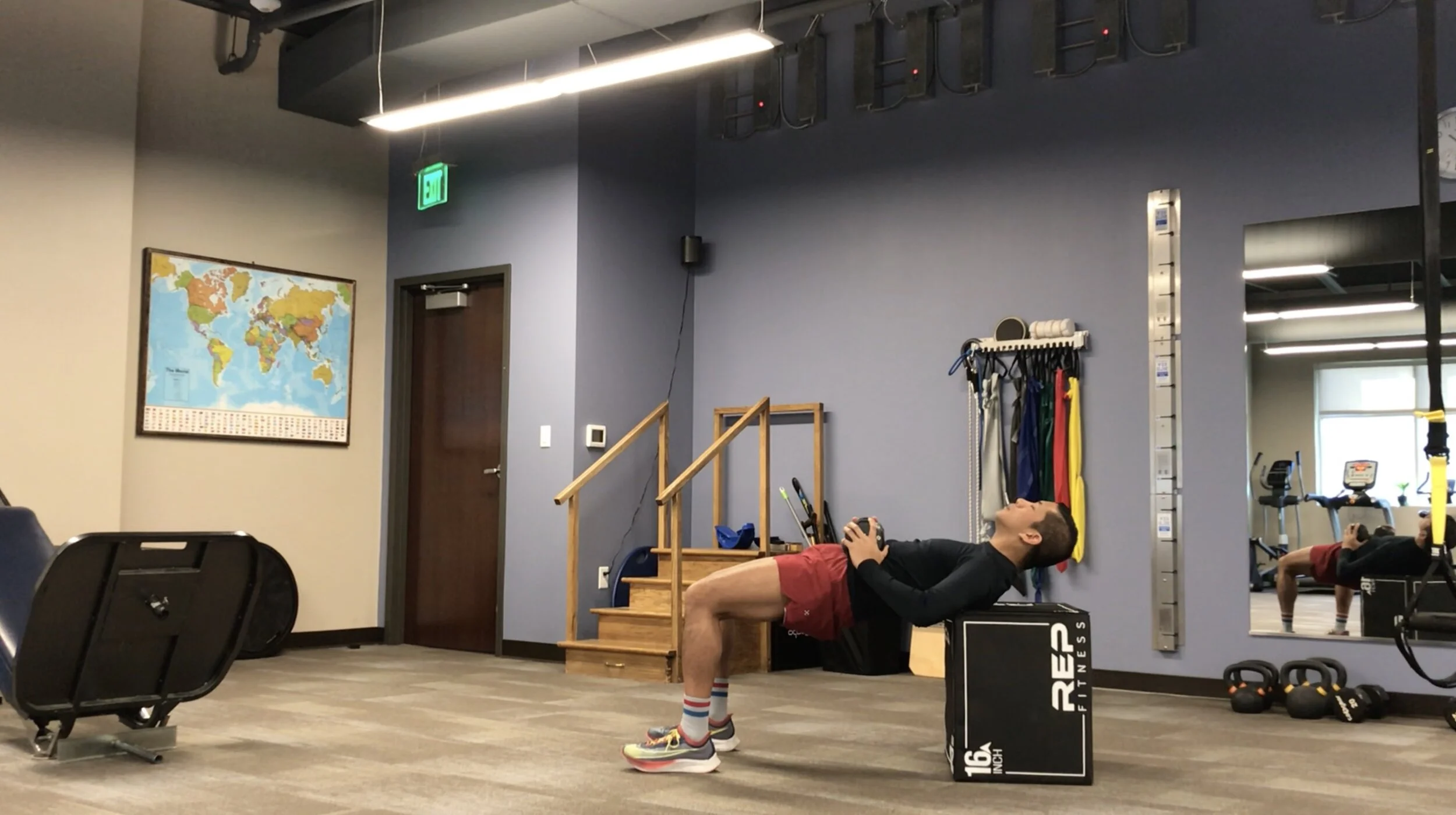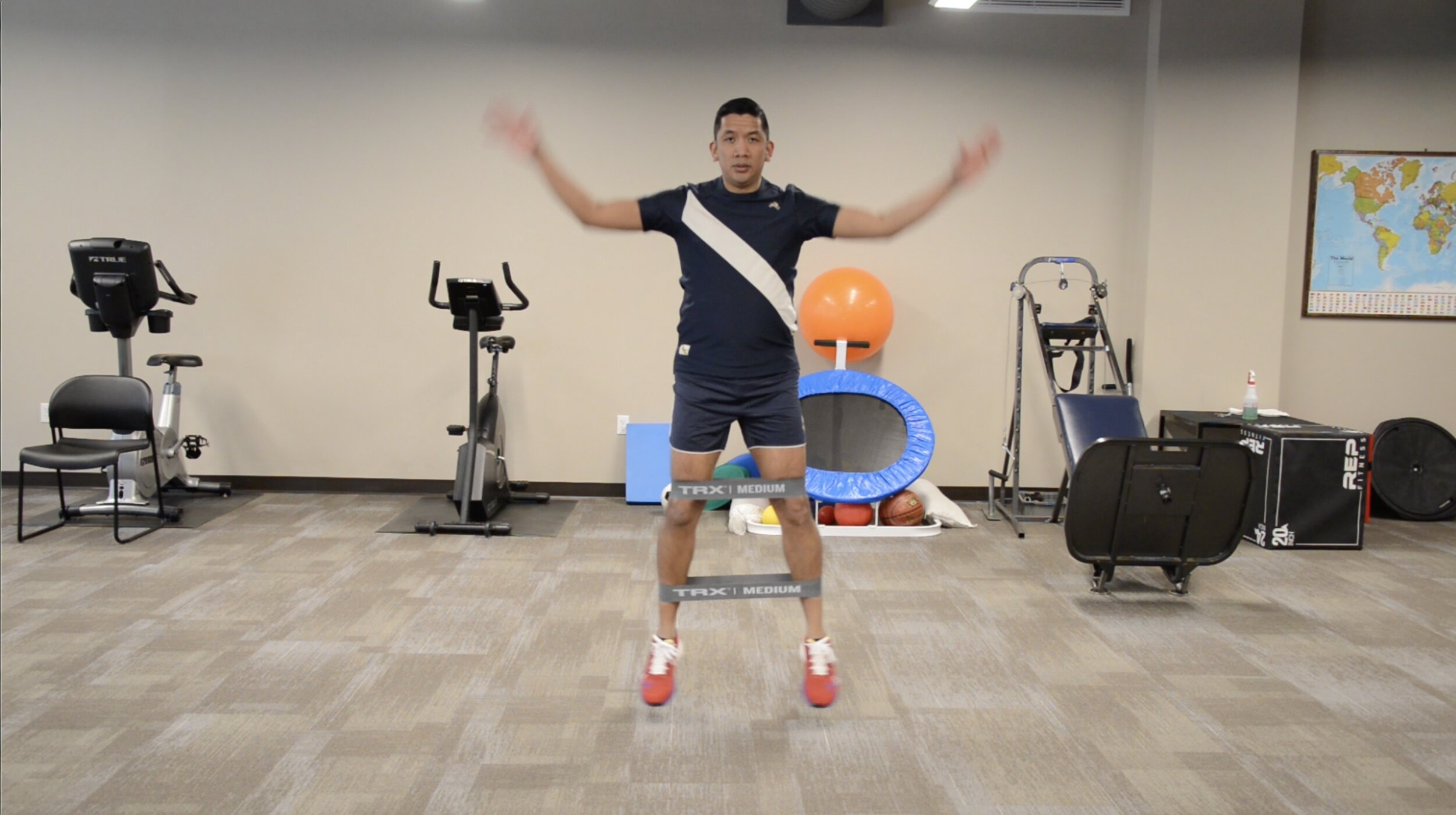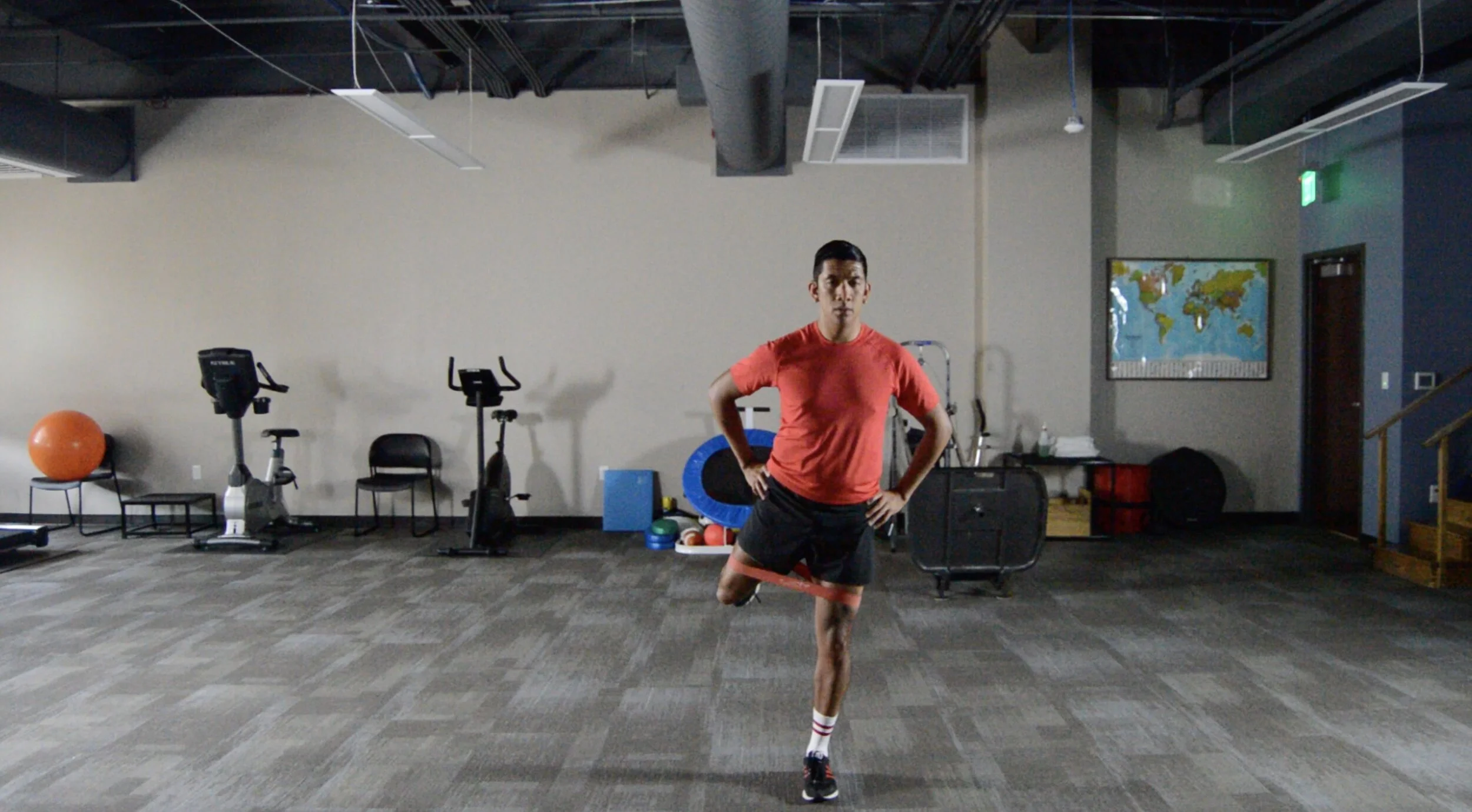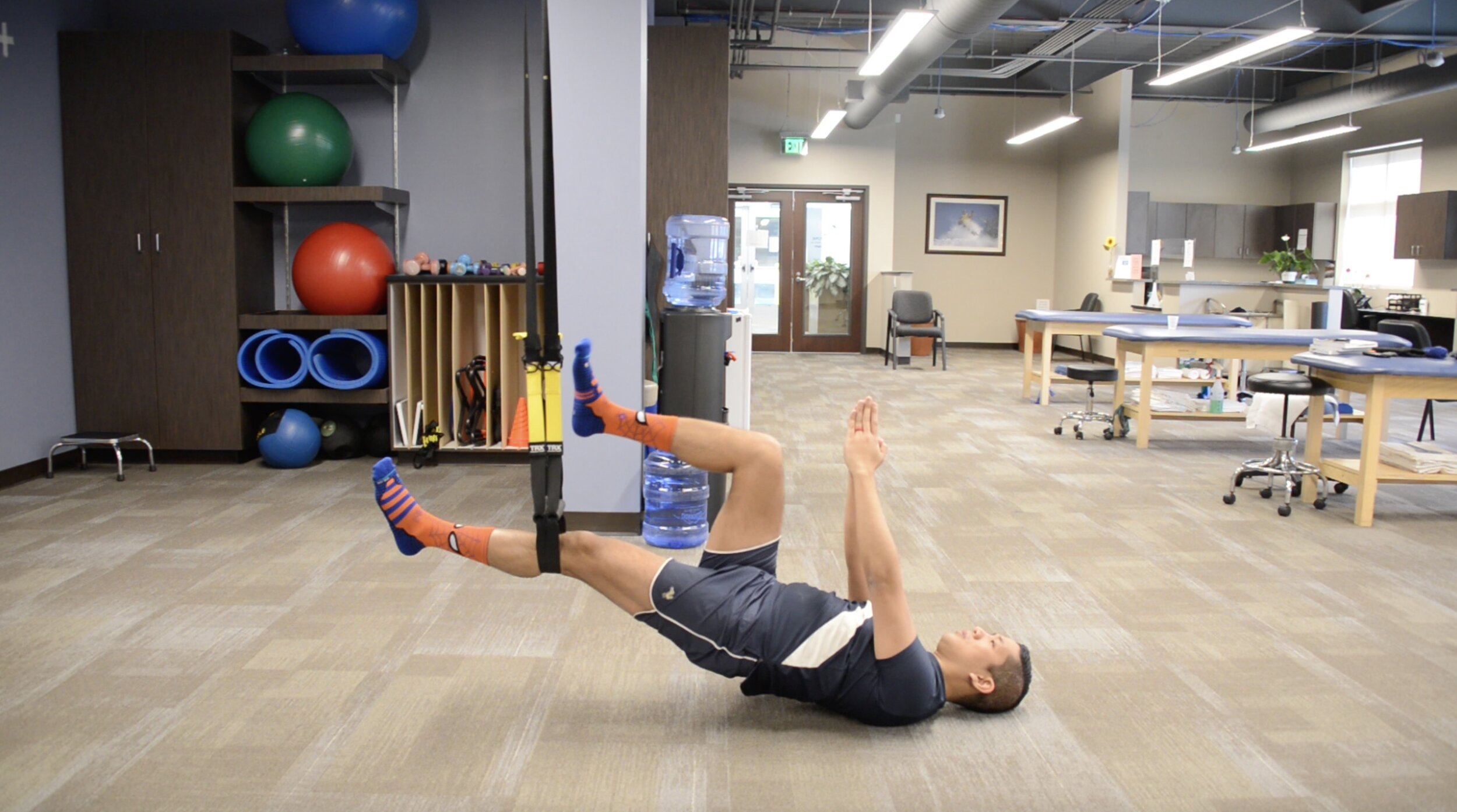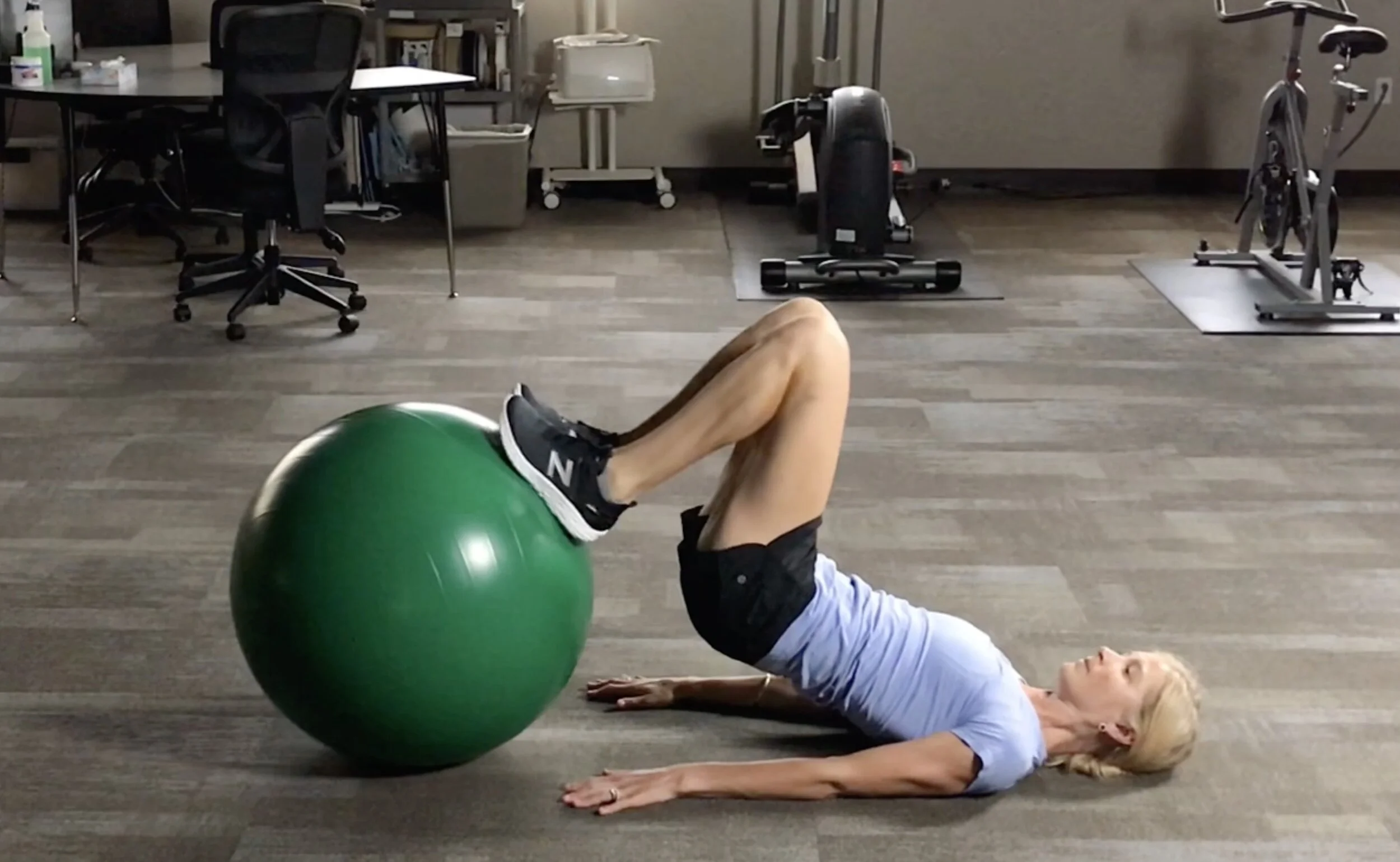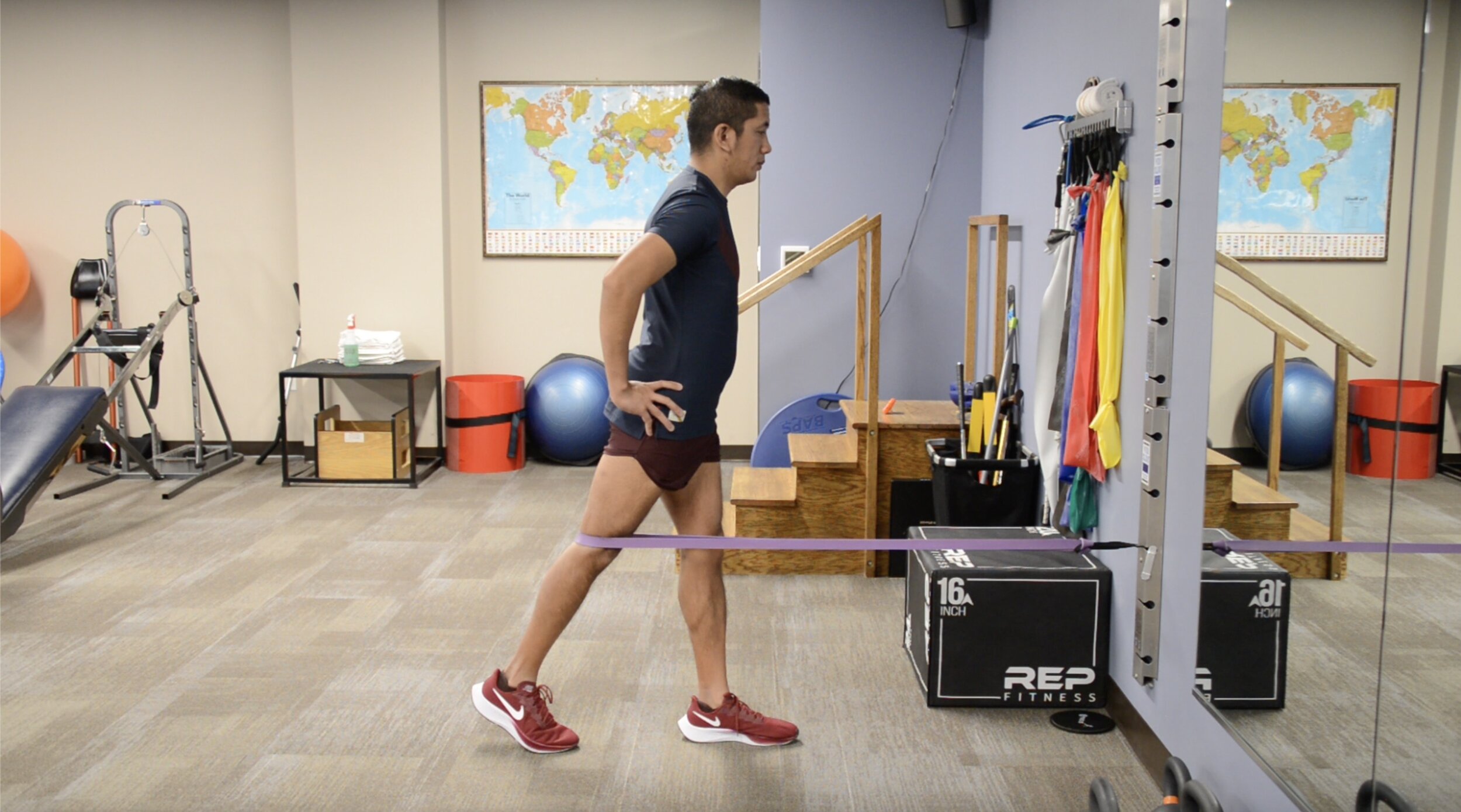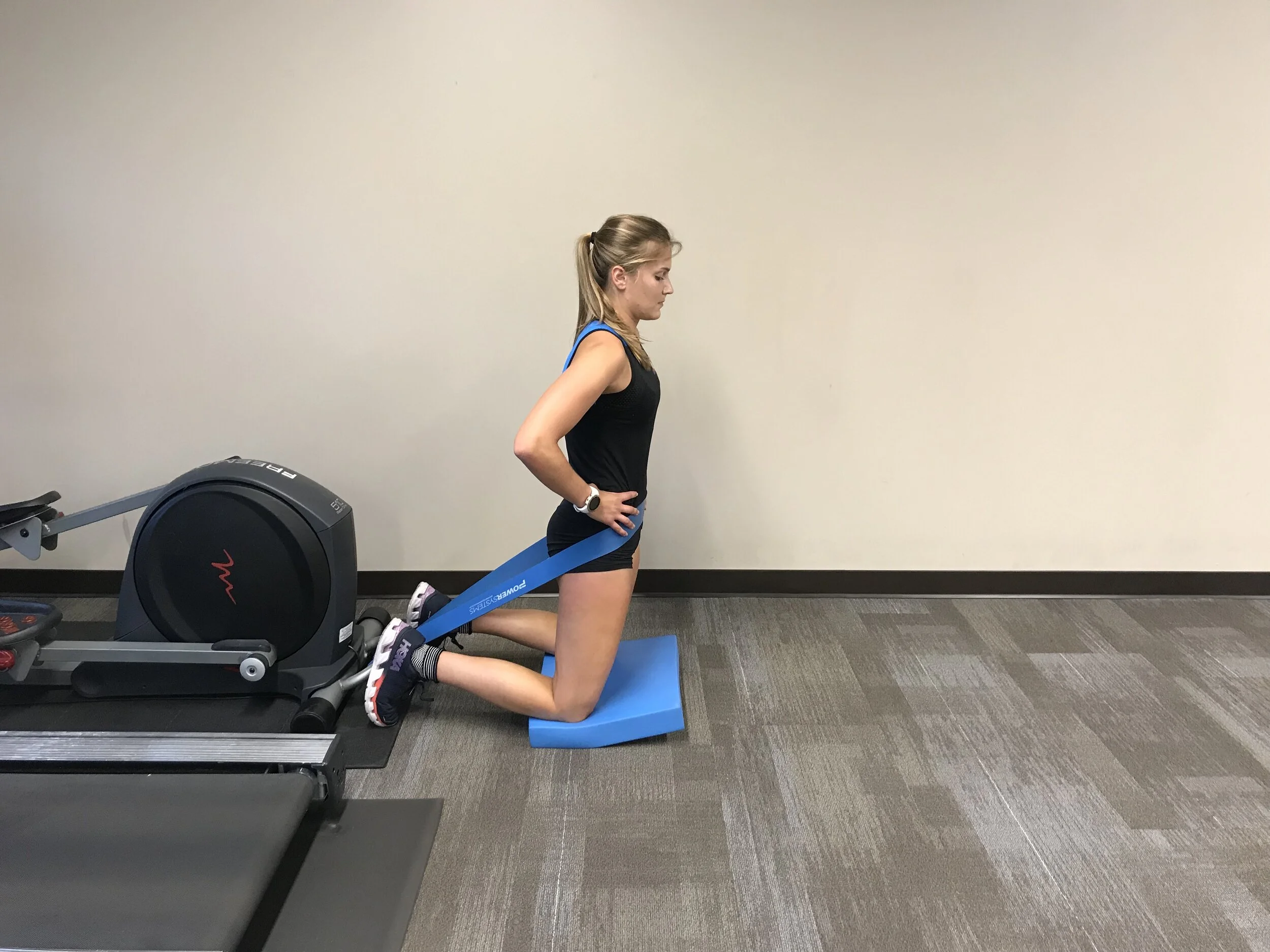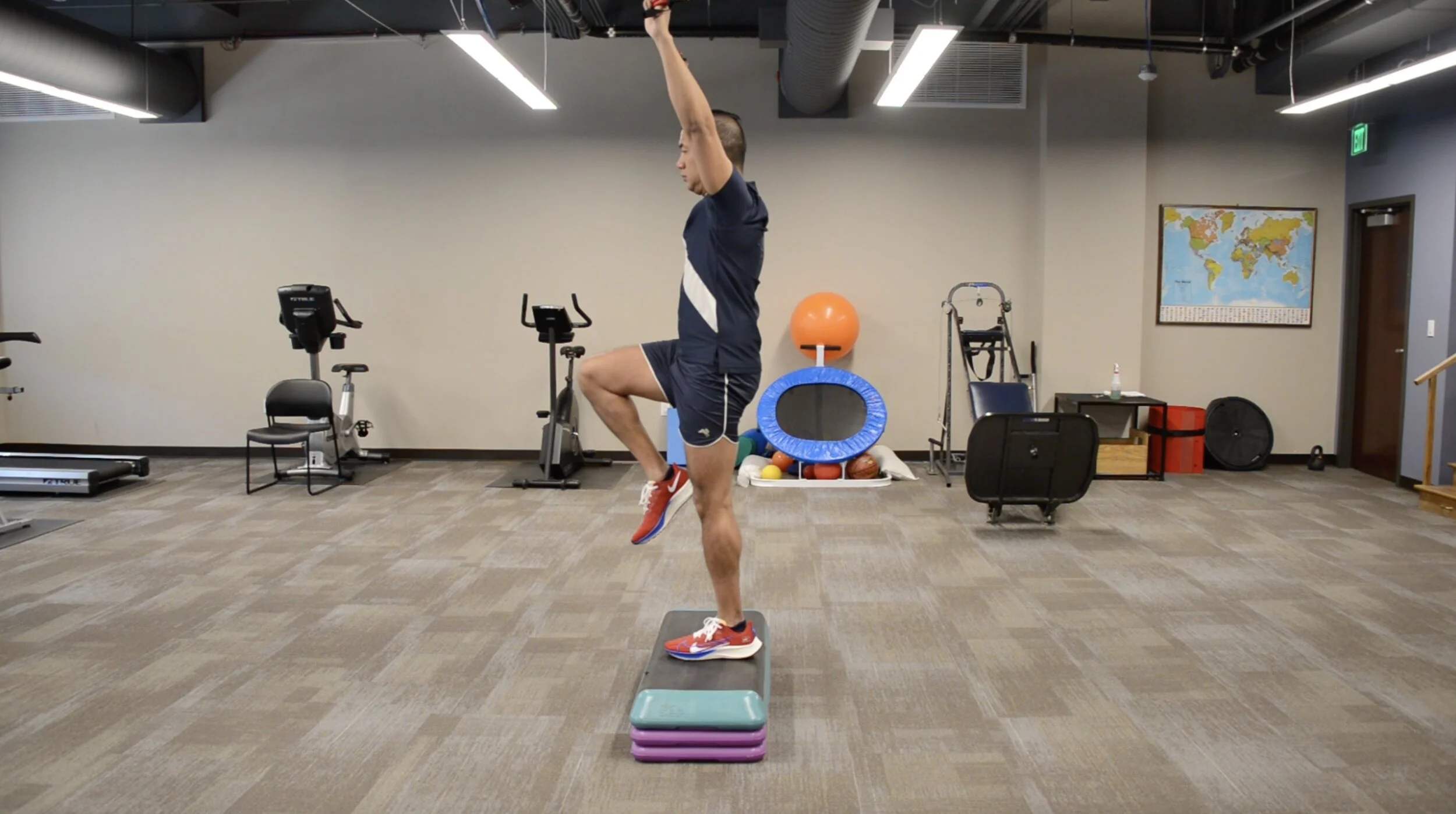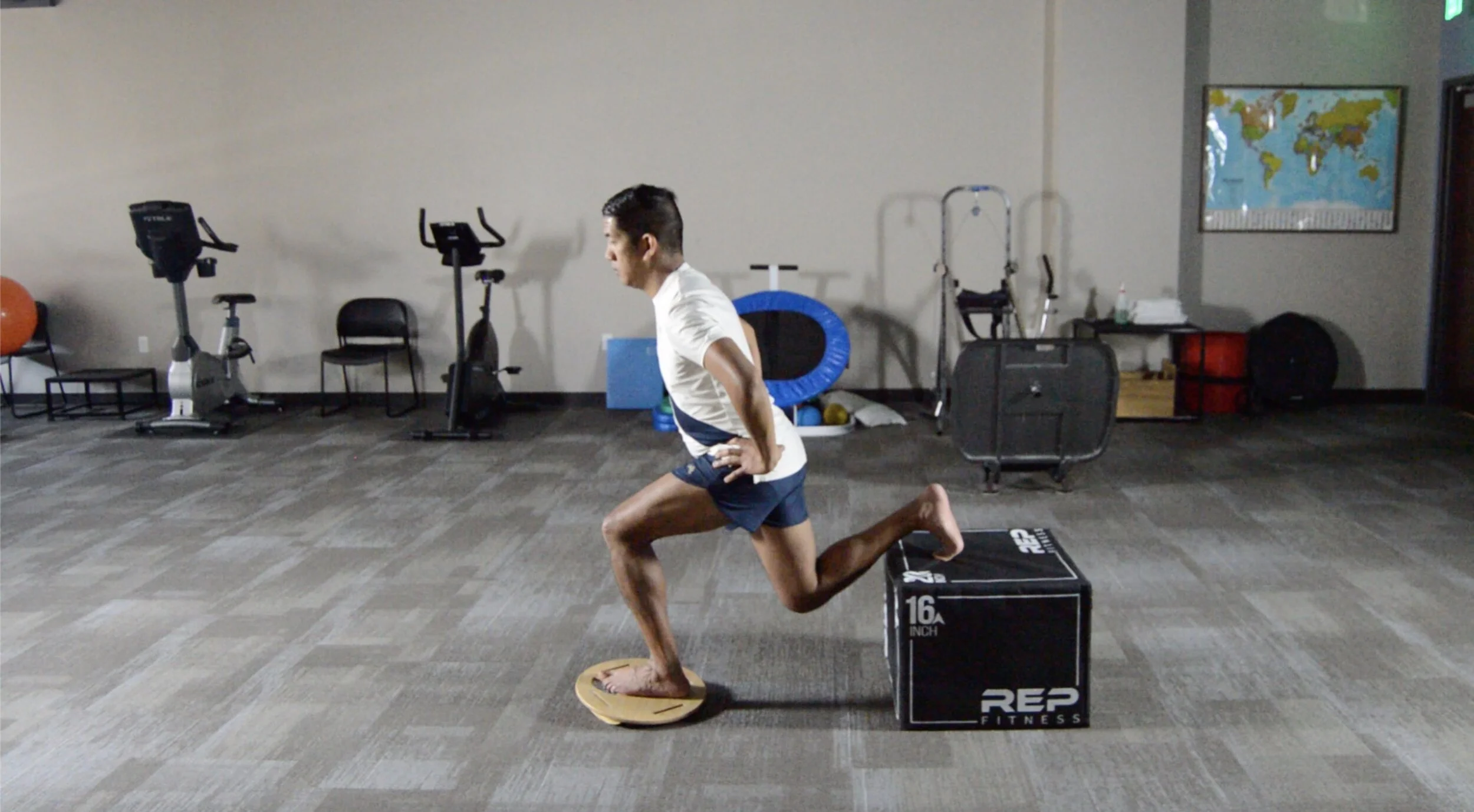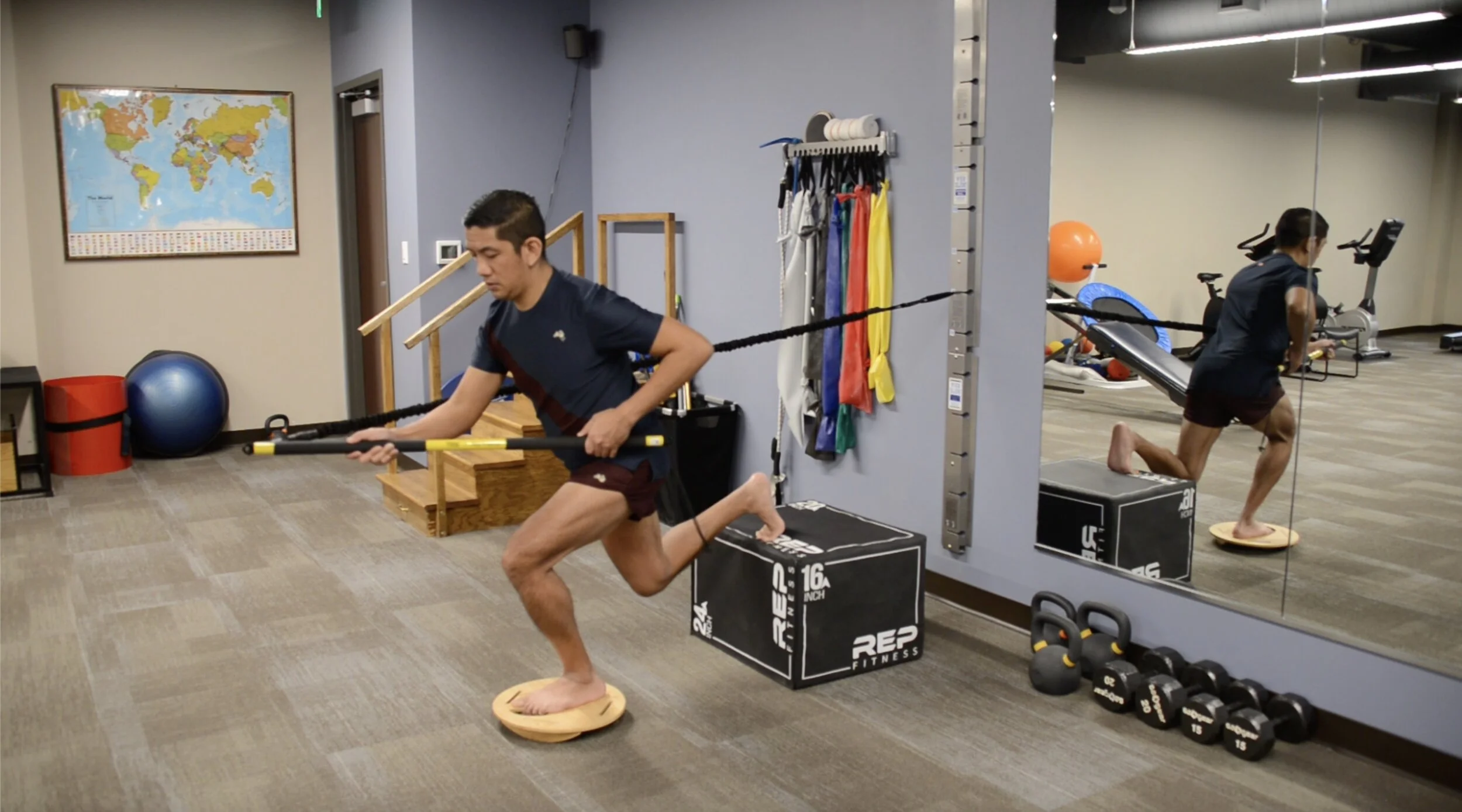
Hip Strength
Bridge series
Lay on your back with feet flat on the ground. Place your hands by your sides or clasped straight up towards the ceiling. Turn the core on by engaging the transverse abdominals. Engage the glutes. Bridge up. Lower down. Release the glutes. Release the core.
Advance your progression by performing a bridge with your heels on a bench or plyo box.
Single leg bridge series
Glute bridge series
Glute bridge
Rest your shoulders on a bench with a 10-25 lbs weighted plate (or dumbbell) on your belly. Place both feet flat on the ground. Slowly lower down and bridge back up by squeezing the glutes.
Split stance glute bridge
Rest your shoulders on a bench with a 10-25 lbs weighted plate (or dumbbell) on your belly. Place one leg up on the toe. Place 90% of your body weight in the grounded leg. Slowly lower down and squeeze the glutes to drive the hip upwards.
Eccentric glute bridge
Rest your shoulders on a bench with a 10-25 lbs weighted plate (or dumbbell) on your belly. Kick one leg straight out. Keep the other knee flexed to 90 degrees. Slowly lower down over 5 seconds on the grounded leg (this is your eccentric lowering leg). Bring the other leg down and bridge up with both legs. This is one repetition.
Frog Bridge
Lay on your back. Bend your knees to about 90 degrees then bring the soles of your feet together with the knees open. Extend your arms toward the ceiling and clasp your hands together.
Drive your hips up as high as possible without arching your back.
Tip - “drive from the hips and stabilize the spine”
Banded bridge
Banded hip kick backs
Lateral toe taps
Place a medium-to-heavy resistance band above the knees. Hinge slightly at the hips and keep your weight in the supporting leg. Gently tap to the side and return to the start position.
Try and use a metronome to maintain a steady and controlled rhythm at either 30 bpm, 60 bpm, or 90 bpm.
Banded diagonals
Banded half moons
Banded hip jacks
Taps n Jacks
Place a medium-to-heavy resistance band above the knees. Hinge slightly at the hips and keep your weight in the supporting leg. Gently tap to the side and return to the start position. Perform 10 taps to each side followed by 10 jumping jacks.
Standing hip circles
Place your hands on your hips. Raise one hip so that your thigh is parallel to the floor and knee is flexed to 90 degrees. Rotate the hip to the side. Keep your pelvis level and knee at the same height and twist your foot behind you. Push your leg straight back. Bring your hip back to center then to the floor. Keep each movement slow and precise.
Banded standing hip circles
Glute rainbows
Start on your hands and knees. Keep a neutral spine and lift your leg behind you such that your thigh is aligned with your trunk and knee is bent to 90 degrees with the bottom of your foot pointed towards the ceiling. Keep your thigh in position and pelvis level while twisting your hip in and out. Avoid arching your back and keep the movement isolated to the hip joint.
Butt scoots
Sling pig-on-a-spit
Lay on your back and place your leg in the suspension trainer placed behind the knee. Raise your hips to come into a bridge position with your arms extended above your chest and palms together. Bring the free leg into 90 degrees of hip flexion and 90 degrees of knee flexion. Keep the sling leg stable and rotate your pelvis to bring your free leg over and under as if you were on a bbq spit. Shoulder blades may come slightly off the ground. Keep a neutral spine with your arms extended above you. All of the inward and outward twisting motion should come from the hips.
Swiss ball adductor rockers
Swiss ball curls
Farmer carries
Banded hip extension
Attach a Powerband to a secure point directly in front of you just below knee height. The band should be taught enough to create resistance but still allow you to move your thigh behind your body. Place your hands on your hips. Maintain a neutral spine. Avoid arching the low back Engage the core to keep the pelvis stable and avoid tilting forward. While keeping the leg straight, extend the hip by dragging your foot backward (if you raise your foot, you’ll recruit the hamstrings NOT the glutes). Keep the glutes engaged as you let the band pull your leg forward.
Modification - Use a foam roller between your chest and the wall to avoid arching at the low back.
Kneeling banded deadlift
Attach a Powerband to a secure point directly behind you at 6-12 inches from the ground. Step inside the band while facing away from the anchor site. Place the band at waist height and kneel onto a pad. Position yourself far enough to feel some tension pulling on your hips. Bend back and sink into your heels. Thrust your hips forward into the band until your hips move into extension. Avoid arching your back as you drive your hips forward.
*This is a foundational exercise that prepares you for RDLs, single-leg RDLs, and other hip hinging exercises. Once you can get into hip extension without cheating lumbar position then you can progress to hip hinging exercises in a standing position.
Step-ups
Stand upright with the step in front of you. Raise the focus leg to place it on the step. Keep the pelvis level. Distribute weight evenly through both feet.
Push up through the heel and straighten the focus leg to transfer your weight onto the step while bending the non-focus leg and drive the knee upward. Hold for 1-2 seconds while standing tall and stable on the stance leg.
Return the non-focus leg to the starting position while engaging the quads to step back with control on the stance leg.
*Tips - Focus on driving from the glutes and proximal hamstring as you step up. This action mimics the propulsive phase of running.
*Start with a 6-8 inch step and progress to a 12-16 inch step.
This exercise can be done with a dowel or 15-20 kg olympic bar raised overhead to integrate postural stability. Alternatively, this can be performed with dumbbells in both hands (either at your side as you step up or moving in a coordinated manner to simulate the running motion) for progressive loading.
Hip thrusts
Place an Olympic bar or kettlebell over your hips and lay on your back with head and shoulders rested on the floor. Place your feet flat on the ground and keep your knees bent. Push your hips straight up while maintaining a neutral spine (don’t go past neutral to avoid irritating your low back).
Romanian deadlift
Single leg deadlift with dowel
Stand on one leg, holding a dowel vertically along your back. Bend forward, making sure that you hold the dowel firmly against your head, mid back, and tailbone, to force yourself to move from the hip and not the spine. Extend your free leg behind you to help counterbalance your body. Push the pelvis forward to help activate the glute as you return to a standing position. Maintain equal pressure across the ball of your foot to improve your stance control.
Ensure that the low back does not round (which will cause you to pull away from the dowel) or that the back does not arch (which will cause the midback to pull away from the tailbone) as you move.
***This is a critical foundational movement to master before trying to move onto weighted deadlifts. Using the dowel helps to reinforce proper technique and form.
Single leg deadlift with landmine
Position one end of an Olympic bar on the floor in the corner to anchor it. With the free end of the bar perpendicular to your body, stand on your outside leg and hold the bar in the opposite hand; let your arm hang down straight. Stand upright keeping the back neutral (avoid arching and extending). Engage your core to maintain a neutral position of the pelvis and prevent it from tilting forward. Perform a single leg hip hinge by reaching back with the opposite leg and creating a straight line from the ankle to the ear while maintaining plantarflexion of the foot at the end range (imagine trying to push something away with the back foot while keeping it as straight as possible). Raise your free arm out to the side for balance if needed. Maintain a neutral spine while engaging your lats as you drive the static foot into the ground and the knee maintains a slight bend. Drive your hips forward to return to the starting position.
Single leg deadlift with resistance tube
Anchor a resistance tube to a secure point at about chest height. Stand upright keeping the back neutral (avoid arching and extending). Engage your core to maintain a neutral position of the pelvis and prevent it from tilting forward. With the resistance tube perpendicular to your body, stand on your outside leg and hold the tube in the opposite hand. While bringing the resistance tube towards your body, perform a single leg hip hinge by reaching back with the opposite leg and creating a straight line from the ankle to the ear while maintaining plantarflexion of the foot at the end range (imagine trying to push something away with the back foot while keeping it as straight as possible). Raise your free arm out to the side for balance if needed. Maintain a neutral spine while engaging your lats as you drive the static foot into the ground and the knee maintains a slight bend. Drive your hips forward to return to the starting position.
MOBO single leg deadlift with resistance tube
Anchor a resistance tube to a steady object such as a squat rack at about chest height. Stand upright keeping the back neutral (avoid arching and extending) Engage your core to maintain a neutral position of the pelvis and prevent it from tilting forward. With the resistance tube perpendicular to your body, stand on the MOBO board with your outside leg and hold the tube in the opposite hand. While bringing the resistance tube towards your body, perform a single leg hip hinge by reaching back with the opposite leg and creating a straight line from the ankle to the ear while maintaining plantarflexion at the end range. (Imagine trying to push something away with the back foot while keeping it as straight as possible.) Raise your free arm out to the side for balance if needed. Maintain a neutral spine while engaging your lats as you drive the static foot into the ground and the knee maintains a slight bend. Drive your hips forward to return to the starting position.
Airplane split squat
Step onto the MOBO board with the slats on 2 and 4. Rest the top of one foot behind you on a bench in a split stance. Drop down into a single-leg squat. Keep a slight forward trunk lean without tilting the pelvis as you slowly lower down. Ensure that your knee does not cross the plane at the front of your toes. Keep your big toe grounded and drive up from the glute to return to the start position. Try to keep the MOBO board as stable as possible throughout the exercise. You can also use an app like “Bubble level” on your phone and place it on the MOBO board for proprioceptive feedback.
MOBO split squat with rip trainer
Step onto the MOBO board with the slats on 2 and 4. Anchor a rip trainer directly behind you. Rest the top of one foot behind you on a bench in a split stance. Hold the rip trainer with the free end on the same side as the MOBO board using an alternating hand grip (palm down on the free end / palm up on the bungee end). Drop down into a single-leg squat while simultaneously bringing the rip trainer across your body. Keep a slight forward trunk lean without tilting the pelvis as you slowly lower down. Ensure that your knee does not cross the plane at the front of your toes. Keep your big toe grounded and drive up from the glute to return to the start position. Try to keep the MOBO board as stable as possible throughout the exercise. You can also use an app like “Bubble level” on your phone and place it on the MOBO board for proprioceptive feedback.
*If you don’t have a rip trainer available, then you can anchor a resistance tube to a secure point to the side opposite your stance leg to create a counter-rotation force. Grasp the handle in both hands and hold it in front of your chest with the tube taught and parallel to the ground. While lowering into a single-leg squat, engage your core and press the handle out with both hands extended in front of your chest. Hold for 1 second while resisting the pull of the tube and not letting your torso rotate towards anchor point. Drive up to return to the starting position while bringing the handle back to your chest.

